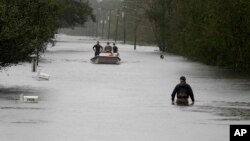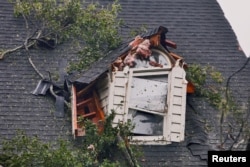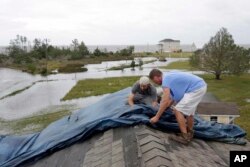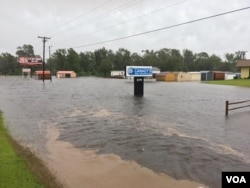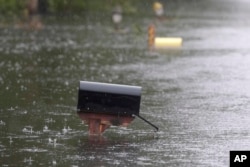At least 11 people were dead and almost a million homes and businesses were without power Saturday as Tropical Storm Florence forced massive evacuations and flooded wide areas of the U.S. South.
The National Hurricane Center said the storm's "heavy rains and catastrophic flooding continue across portions of North and South Carolina." While the winds had eased, the slow movement of the storm meant there was plenty of time for Florence to dump still more rain into already swollen rivers. Florence was downgraded to a tropical depression about 5 a.m. local time Sunday.
But Florence remains a storm that's more about water than wind.
More than 2 feet (60 centimeters) of rain had fallen in places, and the drenching went on and on, with forecasters saying there could be an additional 1½ feet (45 centimeters) by the end of the weekend.
Forecasters also said the storm could kick up a few tornadoes on its trek across the region.
The core of the storm was drifting westward over South Carolina. The hurricane center said that as of 8 p.m. EDT, the core was about 65 miles (100 kilometers) east-southeast of Columbia, the state capital. Its top sustained winds had dropped to 45 mph (75 kph), and Florence was crawling along at 2 mph (4 kph).
The large storm came ashore earlier in the week as a hurricane, flooding rivers, forcing high-water rescues and leaving a trail of destruction.
North Carolina Gov. Roy Cooper said Saturday that despite the downgrade, Florence was still "unloading epic amounts of rainfall" and still very capable of wiping out entire communities.
"The flood danger from this storm is more immediate today than when it made landfall," he said. "We face walls of water at our coast, along our rivers, across farmland, in our cities and in our towns."
Cooper said floodwaters were continuing to rise, and he urged evacuees to "stay put" until they received "the official all-clear."
Gov. Henry McMaster of South Carolina said Saturday that President Donald Trump had assured him "he would do whatever it takes to see that everything is available" in terms of federal resources for South Carolina as it coped with the onslaught and aftermath of Florence.
McMaster said record amounts of rainfall in the Carolinas had been measured — "in feet, in some places, and not inches" — and warned that in addition to the extra rainfall, South Carolina would have to handle flooding from North Carolina that was moving downriver.
Florence was expected to weaken to a tropical depression by Saturday night as it moved inland.
Hundreds of people in North Carolina have been rescued from rising water. Authorities said they had received more than 150 telephone calls to rescue people in the historic town of New Bern alone because water had entered their homes.
Shaken after seeing waves crashing on the Neuse River just outside his house in New Bern, restaurant owner and hurricane veteran Tom Ballance wished he had evacuated.
“I feel like the dumbest human being who ever walked the face of the Earth,” he said.
New Bern resident Latasha Jones was one of the more fortunate ones.
“The evacuation was countywide, but since we’re not in a flood zone, we weren’t really worried about that,” she told VOA.
“The way our house sits, it’s elevated. We have steps on the sides of the house, so it’s a few feet off the ground anyway. And since we’re already on high ground, those two things together kind of help insulate us a little more than, I would say, others,” she said.
Some information for this report came from The Associated Press.
WATCH: Hurricane Florence Comes Ashore




